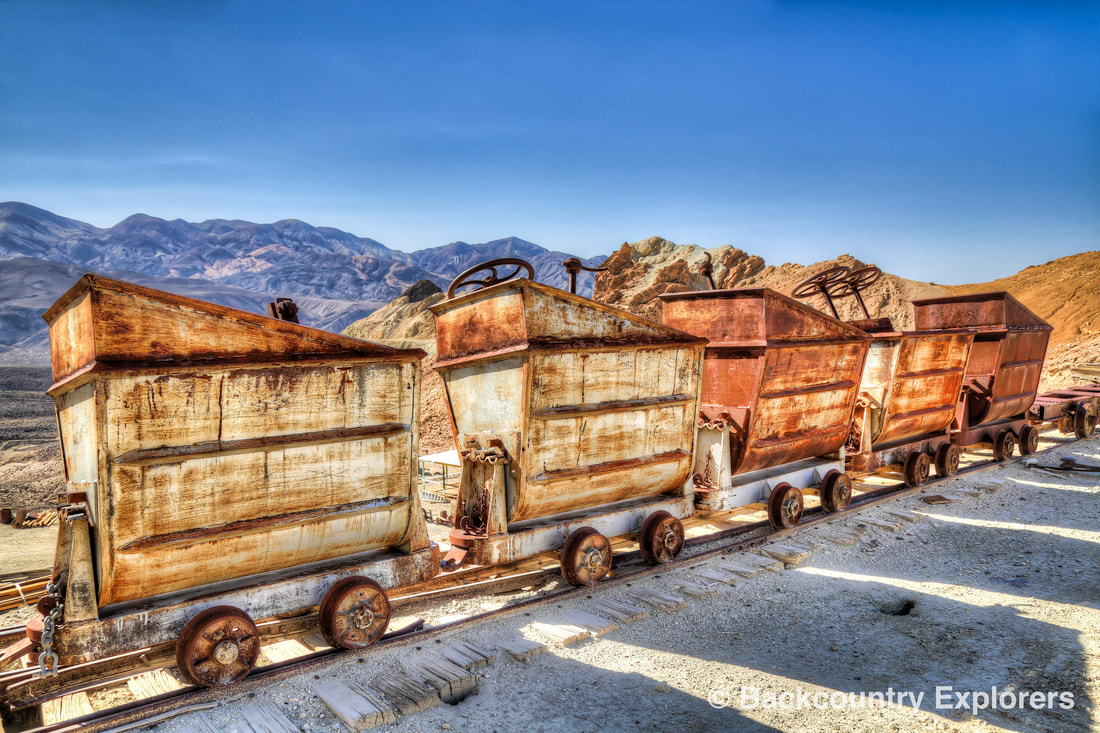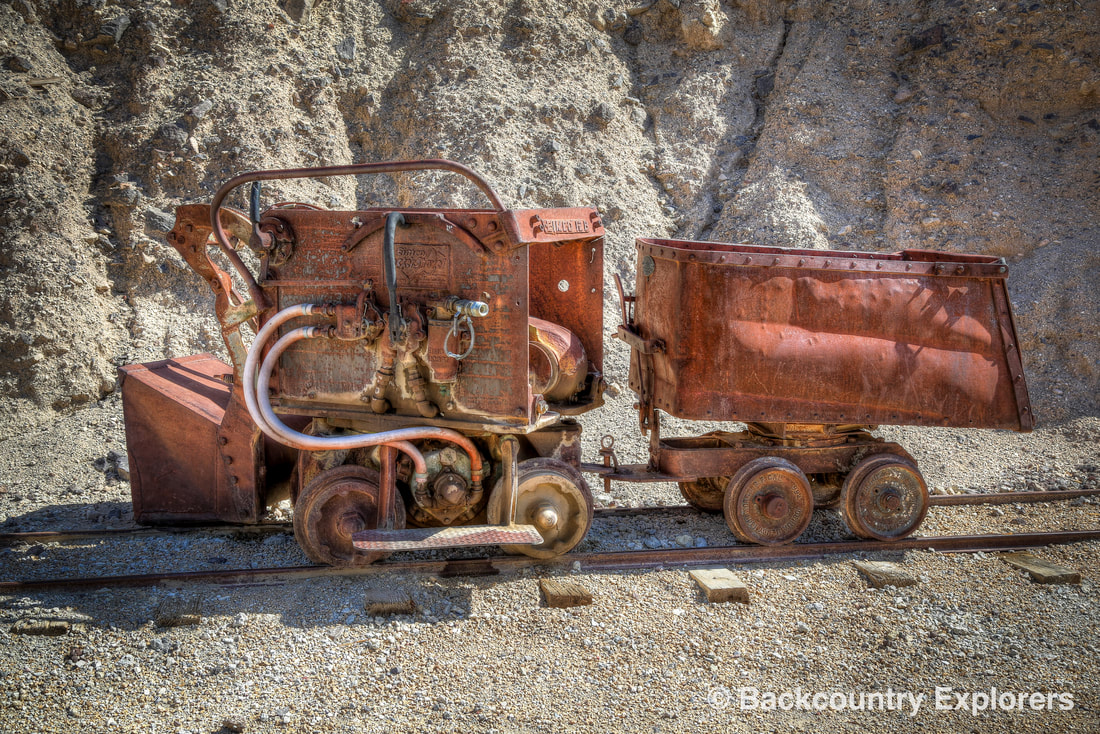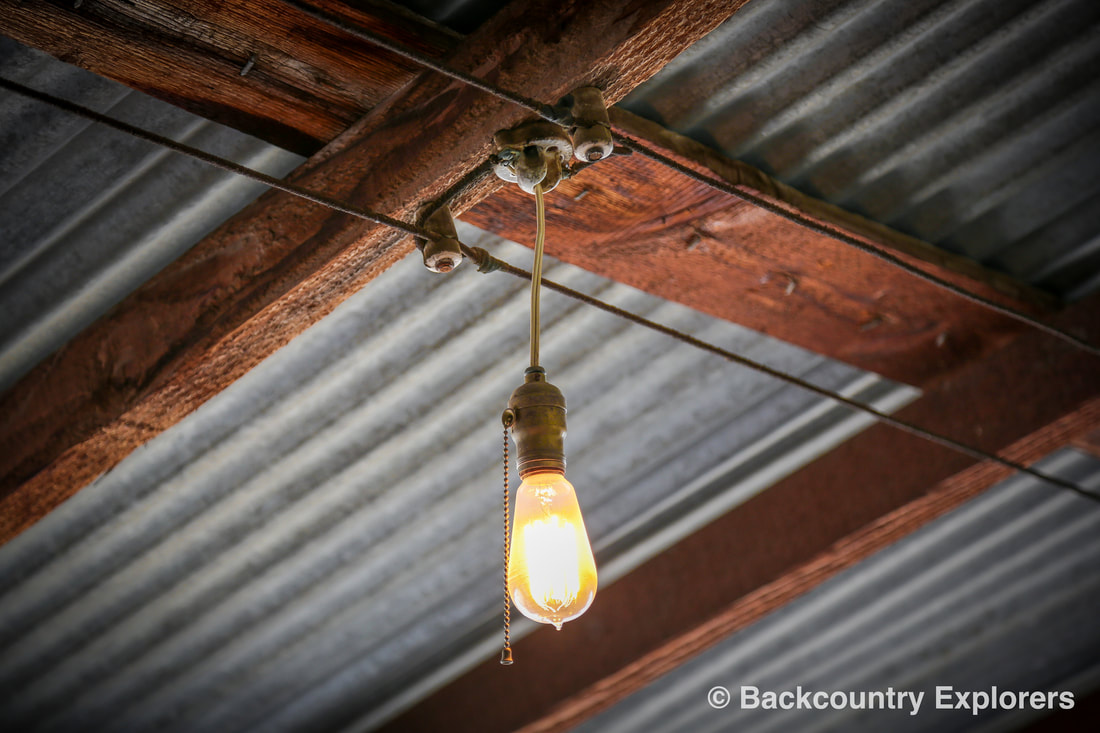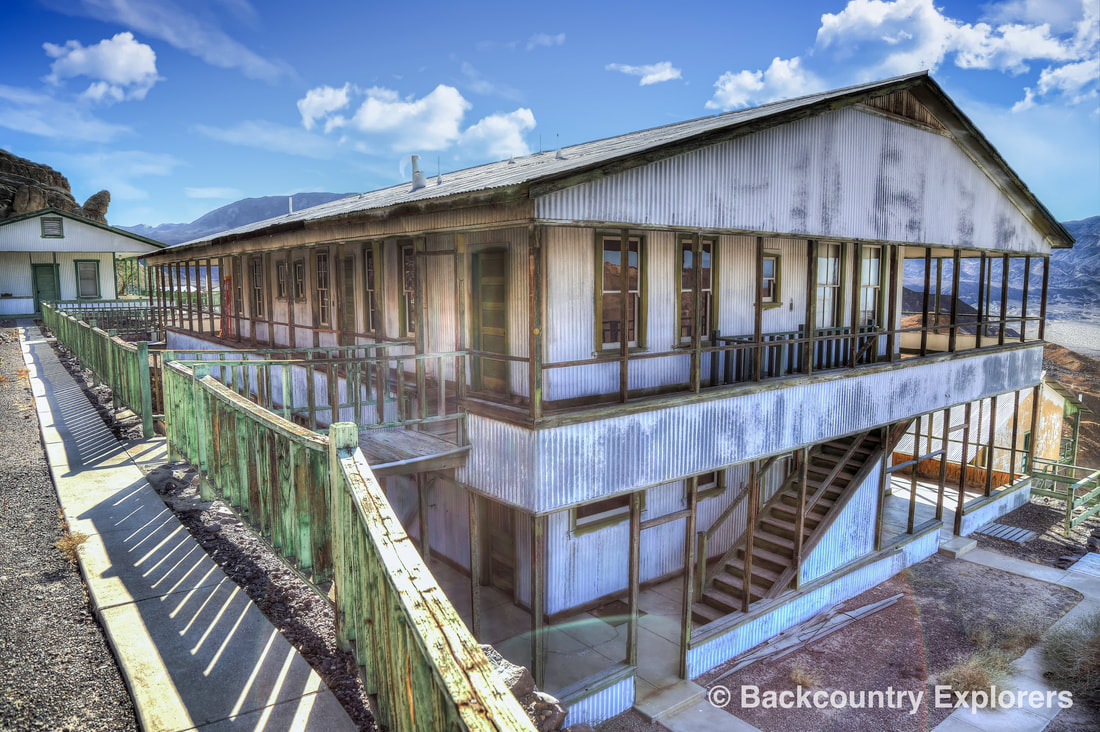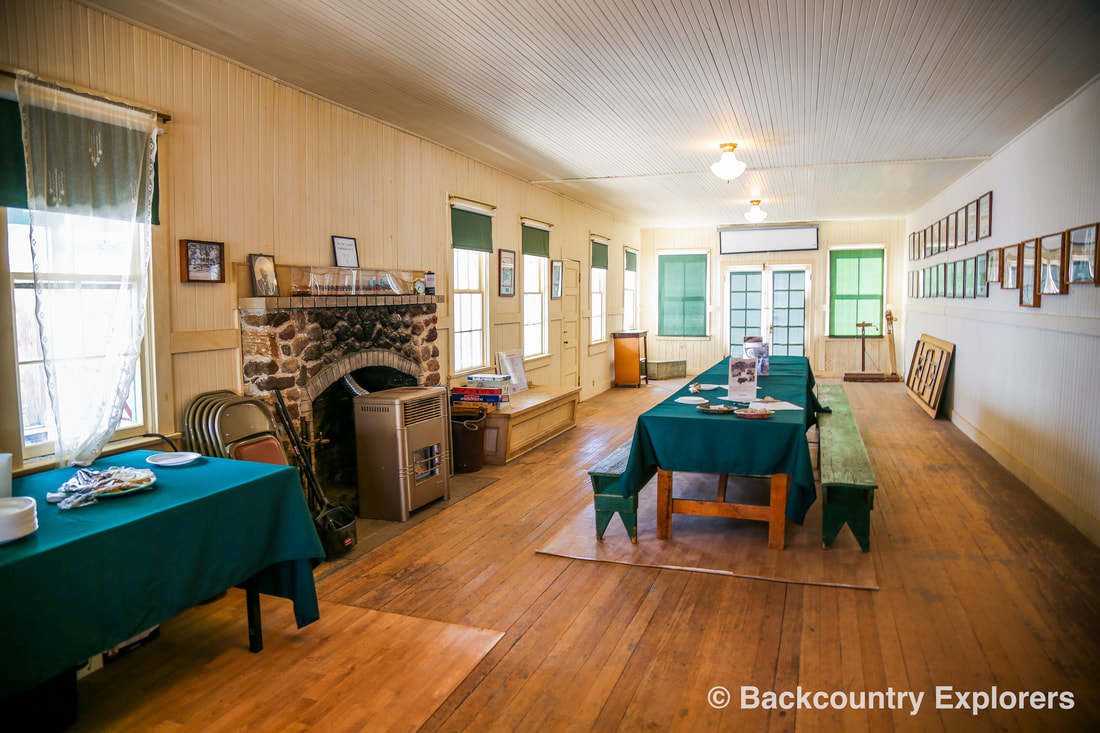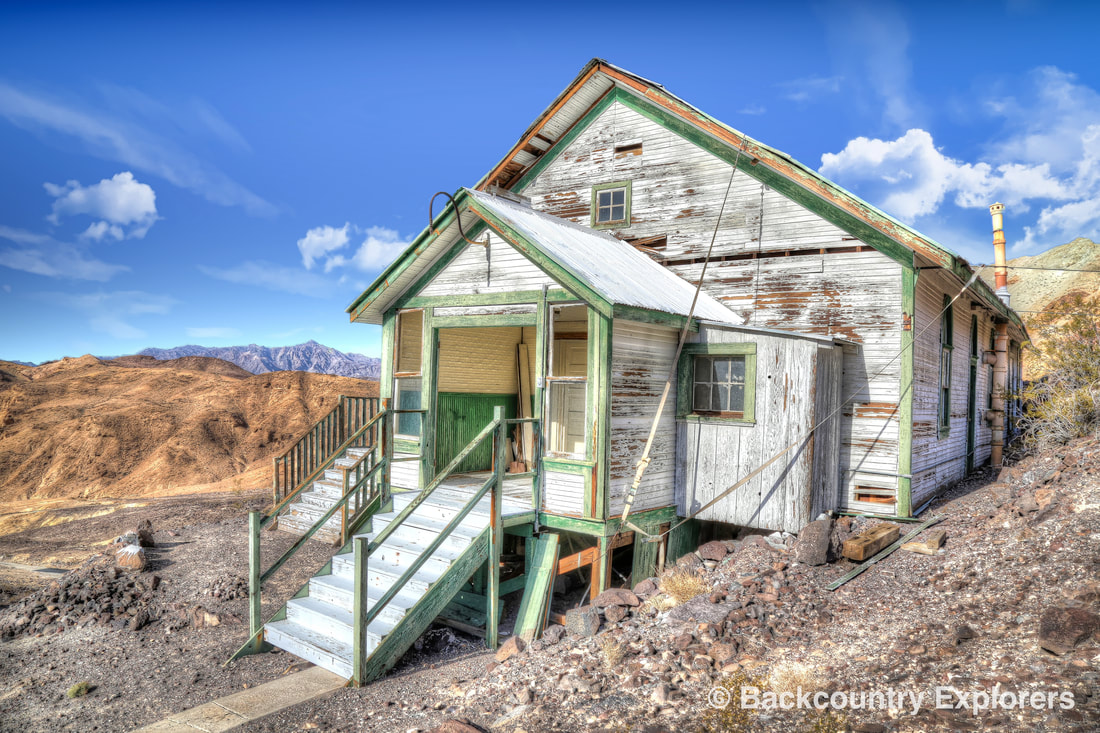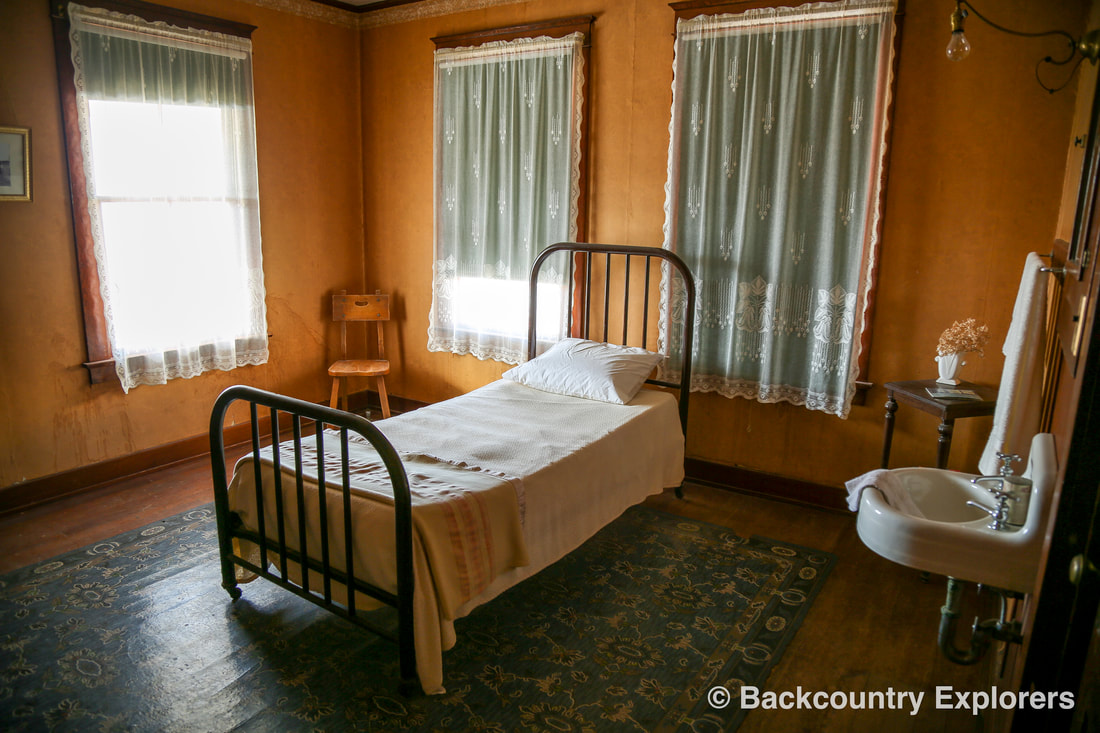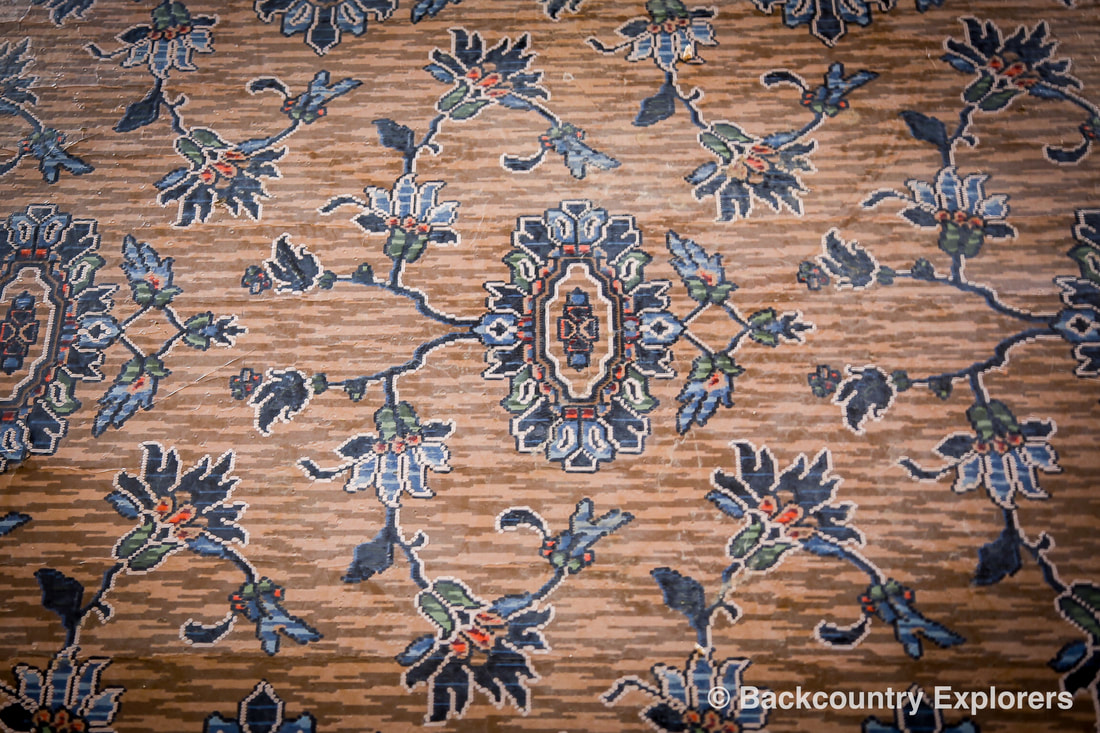Ryan, Death Valley
|
|
We recently jumped at the chance to join a public tour of the historic Death Valley mining camp of Ryan, hosted by the Death Valley Conservancy (DVC). The DVC who are the conservators and owners of Ryan has done an amazing job of tackling the oversight of this very special treasure. We would like to commend them for their passion for preserving and restoring Ryan by being true to the original building techniques and materials that make this a “walk back in time” experience for the public. Of even greater importance is their dedication to making Ryan an education and research destination for many types of students and researchers. As mining history buffs it is so comforting to see that Ryan is in such good hands. Please continue reading to find out what else we learned about Ryan.
Overview
This historic mining camp of Ryan was the Pacific Coast Borax (later U.S. Borax) company's main borax mining operation in Death Valley from 1914 through 1927. Ryan was a luxurious mining camp by any standards of the day including electricity, steam heat, and refrigeration. It also had a school, hospital, post office, recreation hall, and a general store. Borate ores from Ryan area mines were processed at Death Valley Junction and transported there via the narrow-gauge Death Valley Railroad (D.V.R.R.) After the relocating of its mining operations to Boron, Ca, U.S. Borax decided to promote the Death Valley area for tourism; the facilities at Ryan were converted into the Death Valley View Hotel, which operated at full-time until 1930 and on a limited basis until the 1950's. U.S. Borax divested its self of the other hotel properties at Furnace Creek in the mid-1960's; however, Ryan was maintained and protected by a caretaker while serving as a base of operations for U.S. Borax's various mining properties in the area. In 2013 Rio Tinto (formally U.S. Borax) donated the property and substantial funds for its preservation and restoration to the non-profit Death Valley Conservancy (DVC). The DVC is committed to the long-term preservation, restoration, and protection of Ryan. The "mantra" for Ryan project is "preserve what is left and restore where possible." The approach is to sensitively develop the site to support education and research, balancing that use with the preservation of its historic and archaeological resources to convey to contemporary visitors the sense of another time and place in the epic history of Death Valley. The ultimate goal of Ryan is for it to function as a world-class facility supporting scientific research and education in historic preservation, archaeology, and the history. All stabilization, restoration, and other construction activities are guided by the Secretary of the Interiors' Standards for the Treatment of Historic Properties, Standards and Guidelines for Archaeology and Historic Preservation, and Guidelines for the Treatment of Cultural Landscapes.
Ryan remains private property and the staff lives on site full time - PEASE DO NOT TRESPASS. For those interested in seeing Ryan "up close" the DVC offers occasional public tours of the site. As the Preservation and restoration work proceeds DVC will work towards more regular public tours. For further information about the DVC, Ryan, or to be notified about the next scheduled public tour please visit the Death Valley Conservancy website or send an email to [email protected].
The restoration and preservation of Ryan Camp are made possible by the generous donations of Rio Tinto and U.S. Borax, and other individual donors. |
|
The Early Years
The first serious mining of the area occurred in 1884 with prospectors locating colemanite deposits on the Eastside of the Greenwater range in the Amargosa Valley. William T Coleman of Harmony Borax fame bought the claims in 1883 and patented them in 1887. The claims were named the Lila C Mine by Coleman after his daughter Lila C Coleman and were located approximately seven miles from Death Valley Junction. In 1890 Francis "Borax" Smith acquired the mine holdings from Coleman and combined with his other holdings formed the Pacific Coast Borax Company. Smith began mining operations of the Lila C Mine in 1907. |
|
The original mine settlement named the Lila C was renamed Ryan to honor Smith's field engineer and right-hand man John Ryan. At that same time, the settlement of Ryan became official with its own post office. Also around this time, Smith's borax holdings in the Calico Mountains at Borate were about played out and so he had many of the wooden buildings were moved to Ryan.
Though the yearly production far exceeded Francis Smith's expectations at the Lila C, he knew they would not last and sent John Ryan off to scout out other claim holdings. After considerable study, a group of six claims on the West side of the Greenwater Mountains originally located by Coleman's prospectors in 1883-84 became the focus. These six claims, the Upper Biddy McCarthy, Lower Biddy McCarthy, Grand View, Played Out, Lizzie V. Oakley, and the Widow mine, collectively known as the Hillside Group, would provide years of increased production. |
|
In December 1914 upon completion of the 17 mile Death Valley Railroad to the Biddy McCarthy mine the company removed some of the buildings from "Old" Ryan at Lila C and relocated them to their new location on the hillside below the Upper Biddy McCarthy mine. In the move, buildings originally built for Borate and moved to "Old" Ryan were again relocated to the new camp near the Upper Biddy McCarthy mine. This new camp and center of operations was called Devar shortened from the words Death Valley Railroad. USGS maps at the time incorrectly show it as Devair on their map. Either way, the names didn't stick and the growing camp was renamed Ryan in part so that the US Postal Service could keep the same name after relocating to the new site. "Old" Ryan was then referred to as just the Lila C.
|
|
To improve conditions at Ryan, Pacific Coast Borax Company (PCB) purchased and relocated by train an old Catholic church from Rhyolite to Ryan 1918 and refurbished it complete with a stage to serve as a recreation hall and theater. After four of the relocated Borate cabins burned down the company decided to build new dormitories, cottages for staff, and even a schoolhouse. They even produced their own ice with an ammonia ice plant. These changes were completed at the direction of Julian Boyd, Ryan Superintendent, to improve existing employees morale and to attract new ones.
|
|
In 1928 with the development of vast new reserves near Boron, Ca., Pacific Coast Borax closed the mines at Ryan. Around the same time, Pacific Coast Borax decided with the boom in tourism in Death Valley, to form a new subsidiary, the Death Valley Hotel Company, and in 1927 opened the Inn at Furnace Creek. In the same year, they re-developed the old Greenland Ranch adding rustic cabins and changing the name to Furnace Creek Ranch. Also in 1927, they converted Ryan from a mining town into a guest retreat and called it the Death Valley View Hotel. By teaming up with the Death Valley Railroad they were able to transport tourists from Death Valley Junction and the Tonopah & Tidewater railroad siding, directly up to the Death Valley View Hotel in Ryan. During this same period, the existing company buildings in Death Valley Junction were also developed into the Armagosa Hotel.
After the stock market crash of 1929 and the advent of automobiles becoming the primary mode of transportation, tourism by rail in the Death Valley area fell dramatically. By 1930 the Death Valley View Hotel ceased full-time operations and the Death Valley Railroad was closed for good. |
|
The Tonopah & Tidewater Railroads of Ryan
Given that the Lila C Mine was 120 miles from the closest railroad, Francis "Borax" Smith had his second in command, John Ryan, build a railroad from Ludlow siding all the way to Death Valley Junction. The final seven-mile leg Death Valley Junction to the Lila C which was completed in late 1907. Once the focus of operations moved to the six new claims (Hillside Group) on the Western side of the Greenwater Mountains an additional rail line was needed and so Borax Consolidated formed its own 36-inch narrow gauge Death Valley Railroad in 1914. From Death Valley Junction they put the narrow gauge rail inside the standard gauge tracks were it then split off 3 miles from the Lila C and ran 15 miles Northwest to the Biddy McCarthy mine. With this line completed buildings from old Ryan could be moved up to Devar which later became known as the new Ryan location. This new Death Valley line with two Baldwin 2-8-0 Consolidated Locomotives was completed at the end of 1914. There was one train a day, carrying supplies and water up to Ryan Camp and bringing ore back down in the late afternoon. One of these locomotives is on display at the Furnace Creek Museum. |
|
Right after this, the company decided in 1915 to build a less expensive 24 inch "Baby Gauge" railway to support the mines south of Ryan and it was completed to the Widow mine four miles to the south in 1918. The small gasoline (and at least one battery powered) locomotives of the Baby Gauge would haul several ore cars each carrying over three tons of ore. Once the ore cars reached Ryan they were dumped into large wooden ore hoppers that were then emptied into the waiting ore cars of the Death Valley railroad. The DVRR would run the ore back down to Death Valley Junction where it was processed and loaded onto the Tonopah and Tidewater Railway.
|
|
When Ryan Camp transitioned from mining borax into a tourist destination, the Baby Gauge flat cars were fitted with benches to provide tourists with a grand view along the trestles and tracks while heading to explore the now idle Widow mine. Pacific Coast Borax joined the Union Pacific Railroad in promoting Death Valley tourism. The Union Pacific and the Santa Fe Railroads would drop their Pullman cars off at Crucero where the Tonopah and Tidewater would pick them up and take them to Death Valley Junction.
|
|
For the next leg of the trip, the Death Valley Railroad purchased Brill motorcar #5 to bring tourists up to Ryan from Death Valley Junction. This was a 38 -passenger gas powered car manufactured by the J.G. Brill company and started runs in February of 1927. The ride to Ryan took a total of one hour and five minutes. Prior to the Brill car #5, the DVRR had an old coach/baggage car that they sold in 1920. The Brill car #5 can be found at the Laws museum in Bishop, Ca.
Finally, with the Great Depression, the Death Valley Railroad came to an end in March of 1931. The Baby Gauge continued to run tourist trips well after the DVRR closing up till 1949 before shutting down. |
|
|
The Mines of Ryan
Biddy McCarthy Mines (Upper and Lower): A pair of former borate mines located 0.4 mile SSE of Ryan. First operated in 1915. The Upper and Lower Biddy McCarthy Mines are near each other but not connected. Mineralization is a Miocene borate deposit, hosted in rocks of the Furnace Creek Formation (shale, conglomerate, limestone). Calcite, colemanite, and ulexite appear to replace limestone breccia. Workings include underground openings comprised of drifts and stopes The room and pillar method of mining was employed (along with several other methods, rill stoping, square-set stoping, etc). The Upper & Lower Biddy McCarthy mines were the original names. It's been said confusion probably began when the 'McCarthy' part was commonly dropped. The Upper Biddy McCarthy mine became known as the Big Biddy Mine and the Lower Biddy McCarthy mine became known as the Little Biddy Mine. Grand View Mine: A former borate mine located 1.3 miles SSW of Ryan, along Furnace Creek Wash. Mineralization is a Miocene borate deposit hosted in rocks of the Furnace Creek Formation (limestone & Miocene shale). The ore body is 165 feet thick. The deposit extends from the surface to a flat fault 300 feet down dip. Played Out Mine: A former borate mine located 1.3 miles NE of Ryan, at the foot of the western slope of the Greenwater Range. First operated in 1915. Mineralization is a Miocene borate deposit, hosted in rocks of the Miocene Furnace Creek Formation (shale) and sandstone. The deposit dips moderately steeply. Workings include unspecified underground openings. Lizzie V. Oakley and Widow Mines: Former Borate mines located 1.7 miles S of Ryan. First operated in 1915. The Grand View Mine and the Lizzy V. Oakley are located on the connecting rail line between the Ryan camp and the Widow. Both these mines are readily viewed from the Dantes View road. A tunnel was driven from the Widow to the Oakley just before Ryan was closed in 1927. This deposit is a Miocene lacustrine borate deposit hosted in the Miocene Furnace Creek Formation. Workings include surface and underground openings comprised of adits, shafts, drifts, and stopes. The mines associated with Ryan as well as the Lila C remain private property, please do not trespass. |
|
|
Ryan in the Movies
Ryan served as a filming location for both television as well as movies. The Death Valley Days TV series that helped make Death Valley famous included filming in Ryan. At least one Twilight Zone episode also used scenes from Ryan. Stanley Kubrick's 1960 feature film, Spartacus, starring Kirk Douglas, had an opening scene filmed on Ryan's old DVRR grade. Today this film location is still referred to as Spartacus Ridge. |
|
|
|
Sources:
The Death Valley Conservancy (2013) Ryan - Death Valley, Ca. Retrieved from Scott Smith, Superintendent DVC
www.dvconservancy.org
The Death Valley Conservancy, Ryan Camp, Retrieved from Facebook
https://www.facebook.com/pg/ryancampdv/about/?ref=page_internal
Rio Tinto (June 2013) Ryan mining camp Death Valley, California, US Legacy Management case study.
http://www.riotinto.com/documents/RioTinto_RyanMiningCamp.pdf
National Park Service (2003) Death Valley Historic Resource Study A History of Mining, Section lll Inventory of Historical Resources The West Side.
Retrieved from NPS gov. https://www.nps.gov/parkhistory/online_books/deva/section3d3.htm
Jessica L.K. Smith, PhD (Fall 2015) The Story of Ryan - Death Valley’s Best-Preserved Mining Camp. Retrieved from Shoshone Museum Reader
http://www.mediafire.com/file/ohhz8mhcqnap9qx/2015_09_23+Fall+2015+SMR+Ryan+by+J+Smith.pdf
Stephen E. Drew, Chief Curator (retired) California State Railroad Museum (November 2016) Railroad Motor Cars of Nevada - Part lll. Retrieved from http://nevadagram.com/railroad-motor-cars-of-nevada-part-iii/
Mary Ringhoff (May 2012), Life and Work In The Ryan District, Death Valley, California, 1914-1930: A Historic Context For A Borax Mining Community, A Thesis Presented to the Faculty of the USC School of Architecture University of Southern California. Retrieved from USC Digital Library http://digitallibrary.usc.edu/cdm/ref/collection/p15799coll3/id/204573
Paul Thompson, The Death Valley Railroad, Retrieved from the Owens Valley Railway Company Newsletter, Volume ll No.1 http://www.ttrr.org/dv_text/ovrco/ovrco_nl_2-1.pdf
Mindat.org - Mines, Minerals and More. Retrieved from Website
https://www.mindat.org/
The Death Valley Conservancy (2013) Ryan - Death Valley, Ca. Retrieved from Scott Smith, Superintendent DVC
www.dvconservancy.org
The Death Valley Conservancy, Ryan Camp, Retrieved from Facebook
https://www.facebook.com/pg/ryancampdv/about/?ref=page_internal
Rio Tinto (June 2013) Ryan mining camp Death Valley, California, US Legacy Management case study.
http://www.riotinto.com/documents/RioTinto_RyanMiningCamp.pdf
National Park Service (2003) Death Valley Historic Resource Study A History of Mining, Section lll Inventory of Historical Resources The West Side.
Retrieved from NPS gov. https://www.nps.gov/parkhistory/online_books/deva/section3d3.htm
Jessica L.K. Smith, PhD (Fall 2015) The Story of Ryan - Death Valley’s Best-Preserved Mining Camp. Retrieved from Shoshone Museum Reader
http://www.mediafire.com/file/ohhz8mhcqnap9qx/2015_09_23+Fall+2015+SMR+Ryan+by+J+Smith.pdf
Stephen E. Drew, Chief Curator (retired) California State Railroad Museum (November 2016) Railroad Motor Cars of Nevada - Part lll. Retrieved from http://nevadagram.com/railroad-motor-cars-of-nevada-part-iii/
Mary Ringhoff (May 2012), Life and Work In The Ryan District, Death Valley, California, 1914-1930: A Historic Context For A Borax Mining Community, A Thesis Presented to the Faculty of the USC School of Architecture University of Southern California. Retrieved from USC Digital Library http://digitallibrary.usc.edu/cdm/ref/collection/p15799coll3/id/204573
Paul Thompson, The Death Valley Railroad, Retrieved from the Owens Valley Railway Company Newsletter, Volume ll No.1 http://www.ttrr.org/dv_text/ovrco/ovrco_nl_2-1.pdf
Mindat.org - Mines, Minerals and More. Retrieved from Website
https://www.mindat.org/

